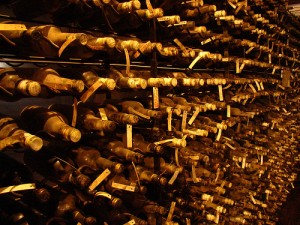I figured that, since my last post was about dessert wine pairings I should do a quick run through on what exactly some of the lesser understood dessert wines are.
Late Harvest/Botrytis Affected/Dried
Sauternes
Sauternes are classified as sweet wines from the Sauternais region in Bordeaux, France. They are made primarily from a blend of Semillon and Sauvignon Blanc grapes (and sometimes a small percentage of Muscadelle). In the best years many of the grapes become botrytis affected (explained here) which concentrates the juice, making it extremely sweet. The process for harvesting these grapes can only be done by hand and for this reason, you can expect to pay a lot of money for bottles from top Sauternes producers ($200+ for half bottles of Ch. d’Yquem in BC, dependent on vintage).
Typical tasting notes in good vintages include the trademark blossom, stone fruits and honeysuckle flavors of botrytis affected grapes, well balanced acidity and sweetness, creamy and viscous texture, with some spice and nuttiness. If spending a small fortune isn’t your thing, try Barsac, a village within the Sauternais region that has the unique ability to classify their wines under the village name. Fairly similar in style, though usually less rich.
Tokaji Aszú
Tokaji is super cool and super underrated. Hailing from Hungary, it is thought to be the first wine produced purposely from botrytis-affected grapes, beginning in the mid-seventeenth century. Tokaji Aszú is made in two steps, the first being to fully ferment a “base” wine. In the second step, aszú (dry) grapes are added. These grapes are either shrivelled by botrytis or raisined. They are allowed to ferment in the base and add sweetness and concentrated flavors. The amount of residual sugar in the wine is what results in it’s designation as a 3-, 4-, 5-, or 6-puttonyos Tokaji.
Intense sweetness, concentrated dry fruit flavors and balanced acidity are typical of these wines. It is relatively easy to find older vintages which have oxidized, meaty characteristics.
Vin Santo
Vin Santo is made in various regions in Italy from grapes that are dried and then aged in small barrels for up to seven years. These wines can be red or white, though white is more common and typically produced from Trebbiano or Malvasia grapes. Sweetness ranges from bone dry to very sweet and are occasionally fortified. Flavors are often nutty, or raisiny, with creamy honeyed notes. Try it with biscotti.
Port
Ruby
Aged for no more than three years in either wood barrels or stainless steel vats, ruby ports are very fruity, tannic, and lend themselves well to a variety of desserts. They are meant to be consumed young and are generally the least expensive port option. It also degrades very slowly upon opening, which means you can keep an open bottle in your cupboard for about a month.
Tawny
Tawny ports spend the most time in wood, anywhere from 10 to 40 years. This balances and rounds out flavors, slightly oxidizes and turns the wine it’s trademark tawny hue. Prices vary, but obviously more time in barrel means a higher price tag.
Late-Bottled Vintage
These ports are aged in wooden barrels from four to six years. They are vintaged and prices vary dependent mostly upon the quality of the vintage. Many are meant to be consumed immediately after they have been released, but some unfiltered LBVs will benefit from up to 10 years in a cellar. Still quite fruity like ruby ports, the tannins are slightly softer creating a more elegant wine.
Vintage
Vintage ports are often considered the top tier and is meant to be aged in the bottle. Most port houses will only produce and declare a vintage if it is an excellent year, allowing those grapes to ferment and sit in a barrel for two years before bottling. Once bottled the house will either keep the port in it’s own cellar for further aging or release immediately. One thing is for sure, though, and that is these wines can develop for a very, very long time. Expect to spend some serious cash for a decent bottle.

